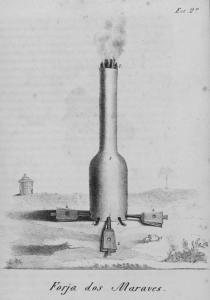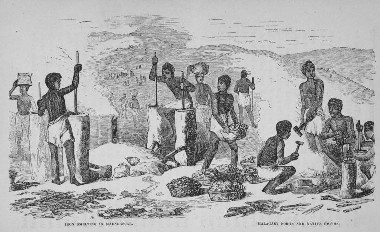
To next page

as described by Edrisi.
---------------------------------------------------
Idris' statement: People of the Zabag (or Zanedj) come hither for iron, which they carry to the continent and islands of India where they sell it for good money, because it is an object of big trade and it has a huge market in India.
This statement finds some support in : Al-Kindi (850) A Treatise to some of his Brethren Concerning Swords: Swords forged from imported steel: Some swords were called non-native. They were forged from imported steel. Some Khurasani swords for example were forged from steel imported from Sarandib and this is the case in several other cities.
Idrisi's description of East Africa as a collection of harbors fully engaged in the production of steel for export to India, stands against the traditional view of a coast that exports ivory and slaves. (Ibn Said mentions a century later also iron mines on the coast).
Although his statement can not be proven it is easy to prove that iron and steel were widely traded in the Indian Ocean. For a statement that East-African iron was traded in the Indian Ocean to little information is available right now. Archaeology shows more that it might have been iron from Madagascar( its coasts where then being colonized by the Swahili)
Starting from several centuries before Christ, the Indians were producing good quality steel. By then it was already used as export article. Later on Arab merchants took it to Damascus were a thriving industry developed in making weapons and armor.
In India it is known as UKKU, and the anglicized version of this is WOOTZ steel. In Medieval times it was known in Europe as Damascus steel. This because the crusaders knew it mostly from the weapons the Arabs made from it. The prophet Muhammad also had a sword made of this steel, most probably imported from India.
S.D. Goitein in his "Letters of Medieval Jewish Traders" has a letter written in Aden about the ship wreck in the entrance to the Red Sea (Bad al-Mandab) of a ship loaded with pepper and "soft iron".(12th century) The ship came from India. Many more letters give evidence in this book about iron products being transported over the Indian Ocean (mostly steel). And Idris himself mentions iron as an import into Arabia from India.
A letter on 11 sept 1149 from Aden to Mangalore by Madmud bin Hasan bin Bundar
...........for pepper....the price per bahar will be 30 dinars, and more, and as for refurbished iron, a bahar will be not less than 20 dinars, and that the raqs (shining glittering iron) which was in the city is completely exhausted. (Tell him also) to dispatch a ship from Manglore, if they can and to send in it any available pepper, iron, cubeb, and ginger..........
another letter
I took notice my master (Abraham Yishu) of your announcement of the sending of refurbished iron in the boat of the nakhoba (shipowner) Ibn Abi 'I Kata'ib . the shipment has arrived and I received from him two bahars and one-third as you noted. (Goitien)
There is some archeological evidence from Madagascar. (cited in General History of Africa III p331-332). " Iron was exploited in the true sense of the word. (in south Madagascar). Here, the metal does not seem to have been worked on the spot, since the usual practice of re-use, attested to by ethnography, is not enough to explain the striking contrast between the abundance of traces of exploitation of the ore (ashes, coal, slag) and the virtual absence of iron objects....... No doubt the smelted products were largely exported through Talaky (harbor in extreme south of Madagascar) whose development, if not foundation thus appears to be linked to its role as an outlet to the sea of export products from the interior, which, moreover, were apparently not limited to smelted products."
Taken from: Iron metallurgy along the Tanzanian coast by Bertram B. Mapunda in Southern Africa and the Swahili world.
As la Violette et al noted: The evidence for smelting declines in the later periods, until there is none at all in the sites that date to the second millennium AD.
Similar observations on the decline of iron smelting industry was observed along the southern shore of lake Tanganyika and in Bukoba.
Smidt attributes the decline to the overexploitation of resources.
Some archaeo-metallurgists conducted a microscopic analysis of metal objects from several sites on the Kenya coast. The results were that the specimens were of crucible steel, indicating they were from imported iron. Because this kind of steel production is unknown south of the Sahara.
The results of the research of Bertram B. Mapunda show that after the first millennium the coastal dwellers changed their production to micro-scale smelting with miniature bowl furnaces and minuscule quantities of ore and charcoal. This mostly because of resource (ore) depletion.
Taken from: Chantal Radimilahy; L'Ancienne Metallurgie du Fer a Madagascar.
Note: XV means XVth century
At Dembeni (Mayoyye-Comores) Xth are found leftovers of forging iron and bits of minerals.
North
Mahilaka: XII to XV the place is an immense workplace for iron
Kingany: Metallurgy from XIII to XIV
Antsoheribory: Metallurgy XIV
Bemanevika: Ironworking XV several cube meters of leftovers
Sandrakatsy: Metallurgy XIII
Highlands
Ambohidahy: traces of Metallurgy in end XV
Andranonandriaana: Metallurgie XV
Ankatso: Metallurgie end XV
Fanongoavana: Metallurgy XV
Vohimasina: Metallurgy end XV
South
Andranosoa: Metallurgy XII to XVII
Lintamandanimerina: Metallurgy XV
Efangitse: Metallurgy end XV
Iabomanitra: Metallurgy XV-XVI
Maliovola: Metallurgy and forging XIV
Taken from: L'extraordinaire et le quotidien: variations anthropologiques : hommage au......by Pierre Verin, Claude Allibert, Narivelo Rajaonarimanana
The coast of North-east Madagascar from 1400 to 1600
There is not only evidence of cultivation and of maritime exploitation, but also of the keeping of large mammals, probably cattle. Traces of local iron working are widespread. There is evidence of widespread production and local transport of chlorite schist basins. We have found workshops near the Iazafo estuary.
Taken from: Nyame Akuma (1995)
Sambava a small town on the north-east coast of Madagascar. A major iron smelting site (14 iron smelting locations) was found 6km from the town. Dated to AD 1300.
------------------------------------------------------------------------------------------------------------
In the many translations as well as in the different manuscripts are so many varieties used of certain names, that I was forced to make this list. About half of them come out of East-Africa and the Orient.
Section 6
Khatt al-istiwa
Carfouna Qarfuna Qarfua Qarfawa Qarquna Carcouna Carfuna Serfouna, Yerd'foun,
Khafouni, Hhafoun
Termeh Barma Tarma
El Hadye Hawiya Hadiya El Haouiya El Haouice
Khakoui Jabel Khaquni Khaqouni Khafouni Djebel Hafouni, Hhafouny
Markah Marka
El-Nedja An-Naja
Carfouna Qarnua Qarnawa
Bedouna Bazuna Baduna Bazua Bazawa Barua Marua Maruwat Berua Merouat B'rwa
M'rwa
Khartan
Merian
Socotra
Cabala Quanbala
Section 7
Medounat Baduna Naduba Maduna Berouat Bedouna
Mulanda Malindi
Manfisa Munfasa Manisa Manbasa Malbasa
El-Banas Bayas
Adjoud Jabal 'Ajrad Ajud
Tohnet Bat-hana at-Tuhnat Batina
Sribuza Jazirat Sharbua Sharbuwa Sharbada Saranda
Andjuba Aqjiya Anjaba
Unguja al-Unfuja Unquja Lanjiuia al-Uqjiya
Wabra Dira Rira
Kahua Karmua Karmadat Karmua Karmaba Karnoa Kermehet
Nerhin Boumin El Boumin
Section 8
Djantama Jantama Hantama Djentana
Dandama Dendema Djentena
Sayuna Safuna Siouna Seyouna
Bukha Boukha Barka
Jabasta Jastama Jasta Jabasta Djetta Djebetta Djesta Gasta
Section 9
Daghuta Daghouta Danghuta
Derou Daduwa Daru Dadu Dadou Dadoua Dhaoura Zaoura
Nebhena Nabhana Iana'ana Inebhena
Dagrha Daghdagha
---------------------------------------------------------------------------------------------------------------------------